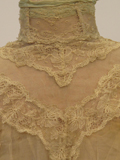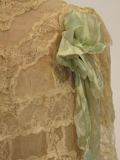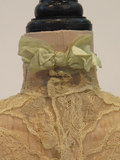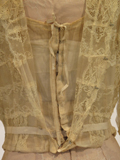This bodice can be dated to the early 1900s based upon its pigeon breast shape, which was typical of the time. It has a voluminous lower sleeve, which was seen between 1905-1910, according to Nancy Bradfield in Costume in Detail. It is made of cream-colored organdy with two different patterns of lace inserted throughout. The fit of the garment is controlled by a boned inner foundation bodice. The inner bodice, middle layer, outside layer, and sleeves come together in the armscye seam. The pigeon breast shape is augmented by a middle layer of gathered organdy in the front and is controlled at the waist by a ribbon. This ribbon has attachment points of thread-covered loops at the center back, indicating that this bodice was meant to be worn with a skirt covering its bottom edge. Green silk bows ornament the bodice at the center back neck and front left breast.
Figure 1: Bodice Front |
Figure 2: Bodice Back |
 |
 |
Inner Bodice
The inner structure of the bodice is made of white organdy, now yellowed. The neckline is scooped low over the bust and so far out on the shoulders that it is only 1/2" wide at the shoulder point. The front piece is cut with the center front on the straight grain and has four darts shaping the bust. The seam allowance of the darts is folded back on itself and stitched to finish the edge. The side seam is slightly farther back than the true side of the garment. The back portion has the straight grain at the center back and is made of three pieces on each side with princess seams which end in the armscye. These seams are also finished by being folded and stitched. A 7" bone is sewn to the center front seam, a 5" bone to the second dart on each side, a 6" bone to the side seam, and a 6" bone to the back princess seam closest to the side seam, as seen in Figure 3 below. The bones in the front are truncated and covered by the binding used on the bottom edge of the garment, possibly showing that they were shortened from their original length.
Figure 3: Interior with Bone Placement |
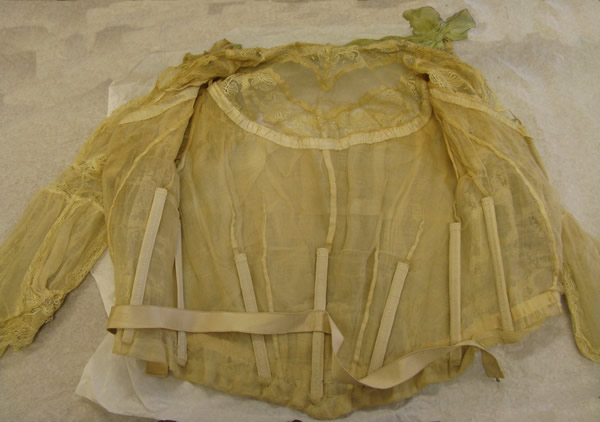 |
The center back of the garment closes with a row of hooks and loops. The hooks and loops are covered with another strip of straight-grain organdy to add to the clean appearance of the interior of the garment. The loop side (left) has a bone inserted under this strip. The neckline is finished with a silk twill tape that has been hand-applied and turned to the inside. A small drawstring runs under this tape and is meant to be tied at the center back. A 1" wide waist tape is attached with cross-stitches to the center front bone 4" from the bottom edge. It closes with a hook and eye at center back.
Across the front of the garment, there is another layer of organdy which adds a bolster to the pigeon breast shape of the front. The straight grain of this piece runs down the center front and across the top. This layer is 21 1/2" wide across the top. It is gathered slightly into 16" at the top edge of the inner bodice. The bottom of the bolster measures 30" which is gathered into 12" at the bottom, where it is caught into the binding at the waist. The bolster is 2" longer than the inner bodice, augmenting the fullness at the front. It is finished in the armscye as one with the inner bodice. At the center front this layer is caught into the silk twill finishing the neckline of the inner bodice. This continues until about two inches away from the armscye, where the layer continues in straight line across and is no longer covered by the twill. This straight edge is hand basted to the inner bodice, leaving a raw edge. The side edges of this piece are unfinished. See Figure 4 below for the placement of the silk twill that supports the bolster.
Figure 4: Silk Twill Supporting Bolster |
 |
Exterior Bodice
The outer part of the bodice is created from two kinds of lace applied as an insertion which are stitched flat on both edges to the organdy, which is then cut away from the back. There is a narrower lace with a leaf repeat motif which is 1 3/4" wide and a flower repeat motif lace which is 2 1/4" wide. While the outer layer appears to have no seams, examination of the grain line of the organdy shows that the traditional seams were hidden beneath the layers of lace and cut away, creating a continuous line of lace around the body. The front has the 1 3/4" leaf-motif lace applied in a V shape directly under the neckline and again about 2" below it. At the point of the lower V, a band of a flower-motif lace that is 2 1/4" wide runs straight across the bust, under the arms, and around to the back. Another band of this flower-motif lace runs 2” below that. Bands of the leaf-motif lace run the length of the bodice to the waist, beginning at the shoulder point in the front, the front of the armscye, the side seam, the back of the armscye, and the shoulder point at the back. Two similar V shapes are echoed at the neck on the back of the garment. The shoulder seam is covered by a band of the leaf-motif lace that hangs loose over the shoulder point by about 3". Leaf-motif lace has been applied down center back and conceals the hook and eye closures, as seen in Figure 5 below and Figure 2 above. The hooks are sewn to the underside of the lace and the eyes are created with heavy thread.
Figure 5:Back Closure |
 |
The collar is created from a single layer of flower-motif lace with five 2" long bones encased in fabric placed to the side of center front, the side neck, and one on center back on the underlap side. The top of the collar is covered in a strip of lightweight green silk, hand stitched on. It ends in a double bow at the center back, which is 4 1/2" wide.
The front of the armscye has two 1/2" tucks that have been taken in under the lace. These tucks are hand-stitched and appear to have been added sometime after the garment’s construction, possibly to fit out fullness in the underarm area without necessitating the removal of the sleeves.
The waist of the bodice is finished with a strip of bias that is folded to the inside of the garment. It is 1" wide on the inside and 3/8" wide on the outside and covers the raw ends of the bones. Above this about 1" is a hand-stitched twill weave ribbon, which compresses the gathers all the way around and is sewn through to the inner bodice, catches all the layers of fabric. On either side of center back, a thread-covered ring is sewn to the ribbon, probably as an attachment point for the skirt.
A large bow of green silk, created by folding a 6" strip of fabric with no central knot, is sewn to the left front of the bodice and has two tails that have a loose knot at each end. The edges have been hand-finished with a rolled hem.
Sleeves
The sleeves are constructed from the same lace as the outer bodice using the same insertion technique. There are four lengthwise strips of the leaf-motif lace on both the upper sleeve and lower sleeve. The lace sits forward and behind the shoulder point and to either side of the underarm. Above the elbow the upper sleeve is slightly gathered into a band of flower-motif lace that measures 10". The lower sleeve is also lightly gathered into this elbow piece. The lower sleeve has the pouched shape that is common during this time period. At the bottom of the lower sleeve, another band of lace, which finishes at 12" with a 2" tuck at the underarm seam, serves as the cuff. The tuck is fastened closed with three thread-covered rings as buttons and thread-chain button loops, as seen in Figure 7 below). The lower sleeve is 3" longer at the back over the elbow than at the front, where it measures 4" in length. This sleeve shape can be seen in Figure 8 below. The armscye seam includes the sleeve, outer bodice, inner bodice, and understructure. It is bound with organdy. At the underarm, the finish on the organdy has been worn away due to use and the fabric is much softer. It shows discoloration and damage that has been repaired.
Figure 7: Cuff Detail |
Figure 8: Sleeve Shape |
 |
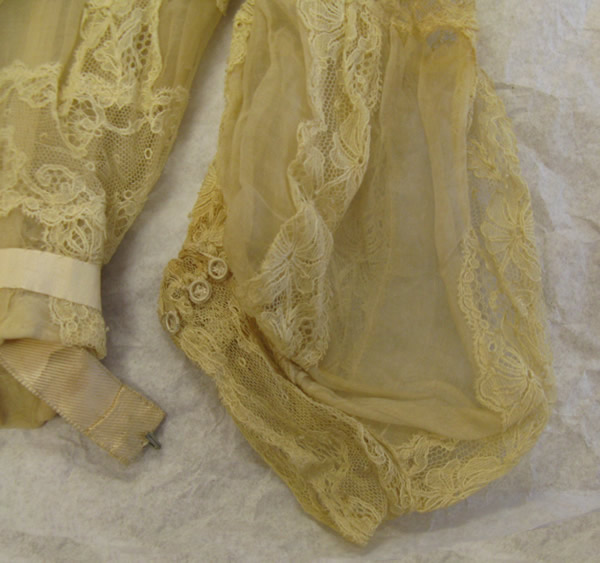 |
Damage
The organdy components of this bodice are extremely fragile. There are several small rips in the fabric on the outside of the garment, especially under the arm. At the underarm, the finish on the organdy has been worn away due to use and the fabric is much softer. It shows discoloration and damage that has been repaired. The lace has been stitched to the organdy with a machine chain stitch. Along with the areas of obvious hand-stitching, this indicates that this garment was most likely a ready-to-wear item and was altered by the owner for fit and style. Small holes under the lace at the shoulder point show small hand stitches as way of repair. The whole garment shows discoloration that indicates it was well-worn and that the original color was most likely white or that of a natural organdy cotton.
© Colleen Dobson, 2015




